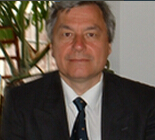Abstract—Power semiconductors operate at different loads with different repetitive frequencies depending on each application. The resultant power loss of a semiconductor can be dissipated as a heat flow or absorbed. In this paper, the thermal path is described frequency-dependent by the power loss input to the thermal mass. The thermal path is defined through the packaging and described by a Cauer model. It consists of thermal resistors and capacitors which depend on the material and which can be realized through a continuous fraction element for each layer. This arrangement causes a frequency dependency of the transmission behavior of the package, which is shown in this paper by using the Bode diagram. Two different systems are described; a diode and a DBC module. The frequency-dependent description using the Bode diagram makes it possible to calculate the energy input into individual layers. Thereby the load of the layer is determined as a function of the amplitude and frequency of the input power. The frequency analysis of the input signal in combination with the material-dependent Cauer model allows prediction of the critical layers.
Index Terms—Power semiconductor, thermal energy inputs, description of the thermal path, frequency-dependent layer composite, Bode diagram.
M. Richter is with the Electrical Engineering and Information Technology Department, Chemnitz University of Technology, 09126 Chemnitz, Germany, and investigates for Robert Bosch GmbH, 71701 Schwieberdingen, Germany (e-mail: martin.richter32@de.bosch.com).
O. Kolleris with the Institute of Maschine Elements, University of Stuttgart, 70569 Stuttgart, Germany, and investigates for Robert Bosch GmbH, 71701 Schwieberdingen, Germany (e-mail: oliverdieter.koller@de.bosch.com).
M. Kopp and R. Schroth are with Robert Bosch GmbH, 71701 Schwieberdingen, Germany (e-mail: michael.kopp@de.bosch.com, ruediger.schroth@de.bosch.com).
J. Lutz is with the chair of Power Electronics and EMC in the Electrical Engineering and Information Technology Department, Chemnitz University of Technology, 09126 Chemnitz, Germany, (e-mail: josef.lutz@etit.tu-chemnitz.de).
[PDF]
Cite:M. Richter, O. Koller, M. Kopp, R. Schroth, and J. Lutz, "Frequency-Dependent Description of the Thermal Energy Inputs in Each Layer of a Semiconductor by Using Bode Diagrams," International Journal of Modeling and Optimization vol. 3, no. 5, pp. 407-411, 2013.


